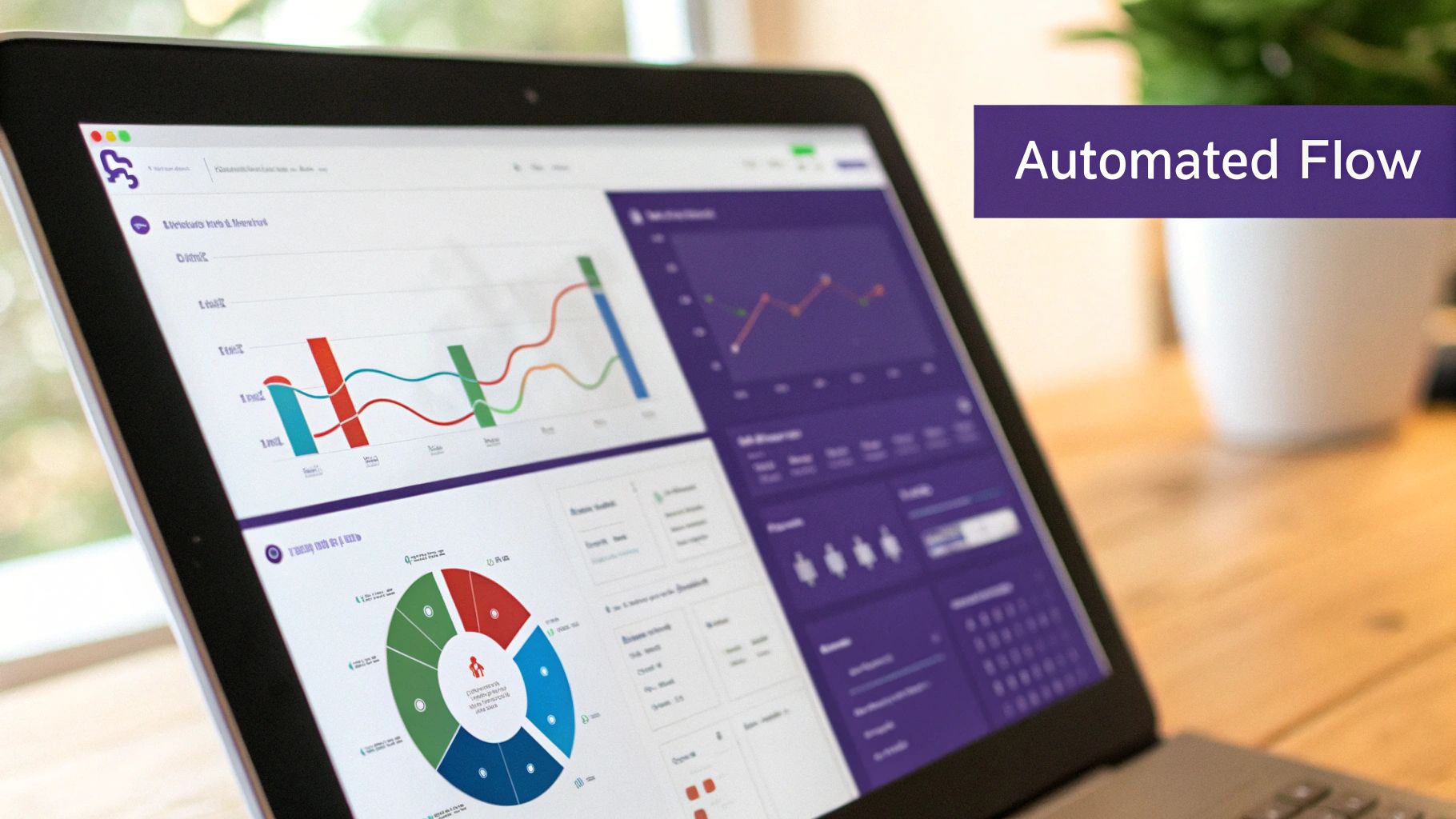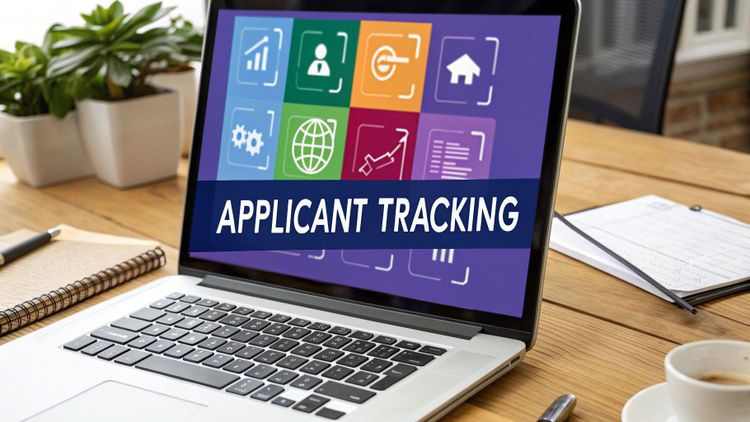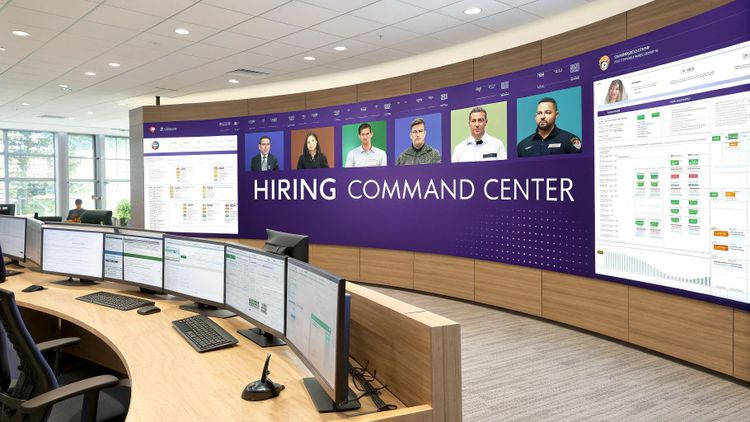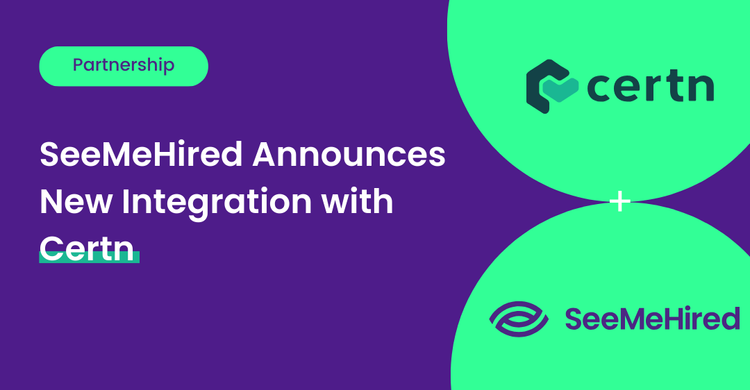HR Tech
What is Applicant Tracking System? Transform Hiring

Understanding Applicant Tracking Systems: Beyond the Basics
An Applicant Tracking System (ATS) is not just a database; it is a software solution that manages the entire recruitment process, from the initial job posting to onboarding. Consider it a centralised hub for all recruitment activities, crafted to make the hiring process more efficient and effective. This shift from manual methods to an automated system allows UK recruitment teams to focus on securing the best talent.
Listen to our Podcast Here:
Evolving from Database to Recruitment Engine
Historically, ATS platforms primarily served as repositories for CVs. However, modern ATS technology has developed into a recruitment engine. These platforms now include automated CV parsing, which extracts key information from applications, and candidate journey management, providing a clear overview of each applicant's progress. This allows recruiters to quickly identify promising candidates and maintain consistent communication.
Growing Adoption Among UK Organisations
This evolution has led to widespread ATS adoption in the UK. Organisations of all sizes are recognising the benefits of centralising their hiring processes. Adoption rates vary based on organisation size, with larger enterprises using ATS more frequently than small and medium-sized businesses. Globally, smaller organisations are increasingly adopting ATS as technology becomes more accessible and affordable. In the UK, sectors such as healthcare and life sciences are driving market growth by acknowledging the advantages of ATS in optimising recruitment. For more detailed statistics, visit: Applicant Tracking System Statistics. This widespread adoption highlights the potential of ATS to reshape UK recruitment. You might also be interested in: What is an Applicant Tracking System (ATS) and Do You Need One?
Turning Recruitment into a Strategic Advantage
Proactive UK employers are using ATS to turn recruitment from a bureaucratic task into a strategic advantage. By automating time-consuming activities, ATS enables recruiters to focus on building relationships with candidates and making strategic hiring decisions. This allows UK businesses to attract and secure top talent more effectively, contributing to their overall success. Increased efficiency leads to quicker hiring times and reduced costs associated with prolonged vacancies.

Key Features of Modern ATS Solutions

Modern Applicant Tracking Systems (ATS) offer a range of features that go far beyond merely storing CVs. These systems are altering how UK businesses manage recruitment, enabling them to be more strategic, efficient, and successful in attracting top talent. This is especially important in today's competitive hiring landscape.
AI-Powered Candidate Matching
A significant advancement in ATS technology is AI-powered candidate matching. This feature goes beyond simple keyword searches by analysing CVs and applications, evaluating skills, experience, and even potential cultural alignment. For example, an ATS might identify a candidate with valuable transferable skills from an unrelated industry, who might otherwise be overlooked by a human recruiter. This automation greatly reduces the time spent manually reviewing applications, allowing recruiters to concentrate on engaging with the most promising candidates.
Automated Communication Workflows
Engaging candidates throughout the hiring process is crucial. Modern ATS platforms streamline this through automated communication workflows. These systems can automatically send communications such as interview confirmations, rejection emails, and feedback, ensuring timely and consistent contact. This not only enhances the candidate experience but also frees recruiters from time-consuming administrative tasks, allowing more time for strategic initiatives such as building relationships with potential hires.
Customisable Pipelines and Integrations
Each organisation has its own unique hiring process. An effective ATS offers customisable pipelines that can be adapted to meet those specific needs. Seamless integrations with other HR systems and popular UK job boards like Reed are also crucial. This ensures smooth information flow and further simplifies the entire recruitment journey. An ATS can integrate with video interviewing platforms, for instance, making remote hiring much easier.
Video Interviewing and Analytics Dashboards
Many modern ATS platforms now include video interviewing features, enabling recruiters to conduct initial screenings or complete interviews remotely. Additionally, analytics dashboards provide data-driven insights into important recruitment metrics such as time-to-hire and cost-per-hire. This data allows UK organisations to continuously refine their recruitment strategies for improved results.
The market has shown notable growth, estimated to be between GBP 58.6 million and GBP 292.3 million in 2023, and is expected to expand further due to the increasing use of cloud-based systems. Find more detailed market statistics here: United Kingdom Applicant Tracking System Market. You might also be interested in reading: The Best Applicant Tracking Systems in 2024.
To better understand the available features, let's compare basic and advanced ATS capabilities.
The table below summarises the key differences between essential features found in basic ATS solutions and the advanced capabilities offered by premium systems.
| Feature Category | Basic ATS Functionality | Advanced ATS Capabilities |
|---|---|---|
| Candidate Sourcing | Basic keyword search, resume parsing | AI-powered candidate matching, social media integration, talent pool databases |
| Communication | Automated email templates | Automated communication workflows, personalised messaging, candidate relationship management (CRM) |
| Workflow Management | Basic applicant tracking, customisable pipelines | Visual pipelines, automated tasks, interview scheduling, offer management |
| Reporting & Analytics | Basic reporting on key metrics | Advanced analytics dashboards, customisable reports, predictive analytics |
| Integrations | Limited integrations with job boards | Seamless integrations with HR systems, job boards, video interviewing platforms, and other tools |
| Compliance | Basic compliance features | GDPR compliance tools, diversity & inclusion reporting, EEO/OFCCP compliance features |
This table highlights how advanced ATS solutions offer a more efficient approach to managing the entire recruitment lifecycle.
Compliance with UK Employment Regulations
Adhering to UK employment regulations is essential. A reliable ATS will include features to ensure compliance with data protection laws such as GDPR, promoting fair and ethical hiring practices. This protects UK organisations from potential legal issues and helps build a reputation as a responsible employer. These advancements help UK businesses attract and retain the best talent in a competitive market.
Measurable Benefits That Improve Recruitment Results

Implementing an Applicant Tracking System (ATS) offers UK organisations tangible benefits, significantly enhancing recruitment outcomes. These advantages extend beyond simple automation, delivering measurable improvements to key hiring metrics.
Reduced Time-To-Hire and Cost-Per-Hire
One of the most significant advantages of an ATS is the reduction in time-to-hire. Automating tasks like CV screening and interview scheduling can lead to substantial improvements. Leading employers have reported reductions of up to 70%.
This efficiency directly impacts cost-per-hire. Organisations spend less on advertising, recruiter time, and prolonged vacancies. These savings can then be reinvested in other strategic HR initiatives.
For instance, an ATS can rapidly filter hundreds of applications, quickly identifying suitable candidates. This allows businesses to fill positions faster, minimising disruption from staff shortages.
Improved Quality of Hire
An ATS not only saves time and money; it also enhances the quality of hire. AI-powered candidate matching and detailed analytics help recruiters identify candidates who are both qualified and a good cultural fit. This contributes to better employee retention and overall team performance.
Structured evaluation processes within an ATS enable more objective candidate assessments. For further insights, explore ways to refine your recruitment process with our helpful guide: Streamlining Your Recruitment Process.
Enhanced Candidate Experience and Employer Branding
A positive candidate experience is crucial for attracting top talent. An ATS enhances this experience by providing clear communication, a streamlined application process, and timely feedback.
This approach improves application completion rates and strengthens employer branding, making the organisation more appealing to potential hires. Automated email updates keep candidates informed of their application status, creating a more professional impression.
Data-Driven Recruitment Decisions and Competitive Edge
An ATS equips organisations to make data-driven recruitment decisions. Access to detailed analytics on key metrics allows recruiters to identify areas for improvement in their hiring strategies.
This data offers a competitive edge in the UK talent acquisition market. Businesses can adapt to changing conditions and secure the best candidates. Furthermore, data insights can inform decisions about diversity and inclusion, ensuring a fair hiring process.
This data-driven approach is increasingly important in the UK. Organisations are striving to refine recruitment strategies and gain an advantage in competitive markets. The data enables continuous refinement of their approach, resulting in more successful hires and a stronger workforce.
Inside the ATS Workflow: From Job Posting to Hire

Understanding the workflow of an Applicant Tracking System (ATS) is crucial for both recruiters and job seekers in the UK. This section provides a practical overview of how an ATS operates, from the initial job posting to the final hire. We'll also explore how UK businesses adjust these systems to suit their specific recruitment needs.
From Requisition to Job Board
The process begins with a job requisition, outlining the need for a new employee. This requisition often requires internal approval within the ATS before the job posting goes live. The ATS then integrates with popular UK job boards, automatically distributing the advert to relevant sites. This saves recruiters significant time and effort.
For example, rather than manually posting to individual job boards, the ATS handles it automatically. This ensures consistent messaging and wider reach. The automated distribution also expands the job posting's visibility, attracting a broader pool of candidates.
Application and Screening
Once advertised, applications start flowing into the ATS. The system automatically parses CVs and applications, extracting key information and storing it in a central database. This allows the system to organise essential details from each candidate, regardless of the application's format.
The screening process follows, where the ATS uses algorithms to filter candidates based on pre-set criteria. These criteria could include keywords, skills, qualifications, or even location. This initial screening helps identify qualified candidates, ensuring only the most suitable individuals progress.
Interview Scheduling and Compliance
The ATS simplifies interview scheduling, automating a previously time-consuming task. The system syncs with recruiters' calendars and sends automated interview invitations to candidates, significantly reducing administrative work. Crucially, built-in compliance features help UK organisations adhere to regulations such as GDPR.
This ensures sensitive candidate data is handled securely, reducing potential legal risks. For example, the ATS can anonymise specific data during parts of the hiring process to minimise unconscious bias. These compliance features protect both the candidate and the organisation.
Offer Management and Onboarding
After interviews, the ATS helps manage job offers. This involves creating offer letters, tracking acceptance rates, and managing pre-employment paperwork. Integrating offer management further simplifies the hiring process, reducing errors and delays.
Some ATS platforms even extend into onboarding. They automate tasks like new hire paperwork and training schedules. This streamlined approach creates a smoother transition for new employees, helping them become productive more quickly. To demonstrate the efficiency improvements an ATS delivers, let's look at the table below:
To illustrate the time saved by using an ATS, we've compiled the following table:
ATS Workflow Timeline
Average time spent at each recruitment stage with and without an ATS
| Recruitment Stage | Time Without ATS (hours) | Time With ATS (hours) | Time Savings (%) |
|---|---|---|---|
| Job Posting | 2 | 0.5 | 75 |
| CV Screening | 20 | 2 | 90 |
| Interview Scheduling | 5 | 1 | 80 |
| Offer Management | 2 | 0.5 | 75 |
| Total | 29 | 4 | 86 |
As the table shows, an ATS can significantly reduce the time spent on key recruitment tasks. This translates to a faster time-to-hire and lower overall costs.
An ATS, like the UK-focused system SeeMeHired, can significantly boost efficiency throughout the hiring process. This leads to quicker time-to-hire and reduced costs, allowing recruiters to focus on building relationships and making strategic hiring decisions. This ultimately contributes to a more effective recruitment process.
Selecting the Ideal ATS for Your UK Organisation
Choosing the right Applicant Tracking System (ATS) is crucial for any UK organisation. With numerous options available, it's important to look beyond basic features and consider your unique needs. This means strategically evaluating your hiring volume, industry requirements, and future growth.
Assessing Your Organisation's Needs
The first step is to assess your organisation’s specific requirements. A small business with low hiring volume will have different needs than a large enterprise hiring hundreds annually. Consider your current hiring processes, pain points, and future goals. For example, if you’re experiencing rapid growth, you'll need a system that can scale.
Key Questions for UK Employers
Several key questions should guide your ATS selection in the UK. GDPR compliance is paramount. Ensure the system adheres to UK data protection laws. Integration with existing HR technologies is also vital for a seamless workflow. Does the ATS integrate with your payroll system? Finally, look for UK-specific functionality, such as integration with popular UK job boards like Reed and compliance with UK employment regulations.
Practical Considerations
Beyond core features, consider practical aspects like implementation timelines. How quickly can the ATS be deployed and integrated? Training is also crucial. How much training will your team need, and what support does the vendor offer? Post-implementation support is equally important. Will the vendor provide ongoing assistance and updates?
Cost and ROI
Calculating the total cost of ownership is essential. This includes not just the initial software license but also implementation, training, and ongoing maintenance. Measuring the return on investment (ROI) is key to building a business case for your chosen ATS. This might involve analysing metrics like reduced time-to-hire and decreased cost-per-hire. Learn more in our article about How to switch to a new ATS in 5 easy steps.
Building Your Business Case
By addressing these factors, you can develop a strong business case for your ATS. This demonstrates the system's value and justifies the investment to leadership. A well-chosen ATS will streamline hiring, improve candidate experience, and ultimately contribute to your success in the competitive UK talent market. Choosing the right ATS isn't just about technology; it's about finding a partner that understands your needs and helps you achieve your hiring goals. A robust ATS will empower your organisation to attract, recruit, and onboard the best talent in the UK.
Overcoming Common ATS Implementation Challenges
Implementing an Applicant Tracking System (ATS), like any major software project, can be challenging. Even with a user-friendly system like SeeMeHired, anticipating potential roadblocks is key. Successfully addressing these challenges is crucial for maximising your ATS investment.
Securing Organisational Buy-In
Gaining support from everyone involved is often the first hurdle. Senior leaders might question the cost, while hiring managers might resist workflow changes. Addressing these concerns directly is essential. Demonstrating the return on investment (ROI) with data and case studies is crucial for convincing leadership. For more insights on cost reduction, check out Ways to Reduce Your Recruitment Costs in 2025. Showing how an ATS simplifies tasks and gives hiring managers more time for strategic work can also encourage adoption.
Effective Training and Transition
A smooth transition relies on effective training. Provide comprehensive training for all users, focusing on features and how they integrate with current processes. Hands-on sessions and accessible support materials are essential. This ensures everyone feels comfortable using the system and can maximise its potential. Addressing initial difficulties and offering ongoing support fosters confidence and long-term use.
Maintaining Momentum
Keeping the project moving can be tough. Initial excitement can fade as teams adapt to new workflows. Regular communication and progress updates are key for staying on track. Celebrating early wins, big or small, reinforces the system's value and keeps teams motivated. Continuous improvement based on user feedback is also vital for long-term success.
Data Quality and Governance
Data quality issues can hinder any ATS. Inaccurate or incomplete data can lead to poor candidate matches and inefficient processes. Establishing clear data governance protocols is crucial. This includes defining data entry standards, implementing data validation, and regular data integrity audits. This proactive approach ensures reliable information for effective decision-making.
Balancing Automation With Human Judgement
Automation is a key ATS benefit, but it needs to be balanced with human oversight. Over-reliance on automated screening can cause qualified candidates to be missed. Make sure your processes include human review. This ensures qualified candidates aren’t overlooked by algorithms and allows for a more thorough application evaluation.
Integration and UK Compliance
Seamless integration with your existing HR tech is essential. Make sure your ATS integrates with your payroll, HR management systems, and other relevant platforms. This streamlines data and promotes efficient workflows. UK employment regulation compliance, particularly GDPR, is also paramount. Choose an ATS with strong compliance features to automate data protection and ensure legal hiring processes. A well-integrated and compliant ATS improves recruitment outcomes and protects your organisation from legal problems.
Streamline your hiring and experience the benefits of a modern ATS. SeeMeHired offers a complete solution for UK businesses, providing all the tools you need to attract, recruit, and onboard top talent.

















